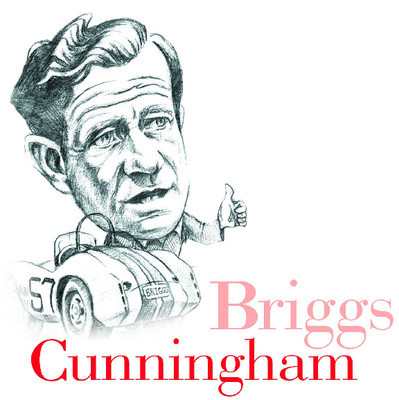Briggs Cunningham paved way for Cobra

In 1962, Carroll Shelby envisioned building a lightweight roadster with a powerful American V-8 under the hood. That vision became the Cobra sports car.
But the idea for such a machine was originally developed more than a decade before by Briggs Swift Cunningham II, sporting enthusiast, gentleman racer and fearless competitor.
As heir to his family’s meat-packing fortune, Cunningham had the means to pursue practically any extracurricular endeavor he wished. Sports was his passion and auto racing, in particular, consumed him.
But it wasn’t until 1948 when the 41-year-old Cunningham turned his first few laps on a race course. In those days, as it is today, one of the most prestigious and grueling races in the world was the French 24 Hours of Le Mans. It was also an event utterly dominated by Italian, German and British race cars. Cunningham decided to rise to the challenge and see if he couldn’t make history in the process.
In 1950, Cunningham fielded a two-car team for the big endurance test. One was a nearly stock Series 61 Cadillac coupe equipped with a 160-horsepower 331-cubic-inch V-8. The other was similarly powered, but was wrapped in one of the strangest bodies ever displayed on a race car. Its appearance was that of a bar of soap, having both front and rear wheel skirts and a boat-tail rear end. The car appeared almost homemade despite being designed and built by several Grumman aircraft engineers during their off hours. Dubbed “Le Monstre” (the Monster) by the French press, this Cadillac-powered oddity managed a respectable 11th place finish, despite an off-track excursion where Cunningham spent more than a half-hour vigorously digging the car out of the sand with his bare hands.
The stock-bodied Series 61 coupe ended up in 10th place overall, one position ahead of boat-tailed Caddy racer.
The same year as his first Le Mans effort, Cunningham built his own sports car, the C-1 roadster, followed in 1951 by the C-2R. The latter of the two was the first to use Chrysler’s 331-cubic-inch Hemi V-8 engine, replacing Cadillac as Cunningham’s engine of choice.
Both models were reasonably quick, but ultimately too heavy for competitive endurance racing.
Cunningham’s most successful race car by far was the 1951 C-4R, an aluminum-bodied roadster fitted with a modified 325-horsepower Chrysler Hemi engine. From a performance standpoint, the C-4R could sprint to 60 mph from rest in around six seconds. Cunningham’s West Palm Beach, Fla.-based company was supplied with engines and technical advice from Chrysler, whose key executives had taken a keen interest in his activities. This type of support was necessary to win, as each engine was worth around $60,000, a huge sum of money 50 years ago.
Cunningham’s C-4Rs were painted white with two broad blue racing stripes running the length of the car. This scheme was later copied by Cobra-maker Carroll Shelby for his Mustang-based GT350 racers.
Weighing considerably less than earlier efforts, the C-4R proved not only competitive, but virtually bulletproof.
Cunningham and his team entered the C-4R in the 1952 Le Mans race. Out of a possible 24 hours behind the wheel, Briggs Cunningham himself drove 191/2 hours straight, allowing his co-pilot to drive only near the end. By the time the race was over, the C-4R had finished first in class and fourth overall. This was an amazing result for a small, single-car entry that lacked the kind of resources available to the European teams.
Over the next two years, the three C-4Rs that were built collected a total of 15 first-place finishes along with five seconds and five thirds at race venues such as Sebring, Fla., Watkin’s Glen, N.Y., Elkhart Lake, Wis., and Riverside, Calif. During that period, the cars never broke down and none crashed.
Team Cunningham was so successful and popular, it was featured in the April 26, 1954, issue of Time magazine.
Aside from the C-4R, Cunningham also built the road-going C-3 coupe and convertible. These Italian-designed beauties, which also featured Chrysler Hemi power, cost a small fortune, resulting in fewer than 30 being produced from 1951-’55.
Cunningham made further attempts at winning Le Mans outright with newer models (one with a four-cylinder Indy-style Offenhauser engine) but with little success.
After the 1955 season, Cunningham ended his car manufacturing business. But he and his team members continued to race other marques, such as Jaguar, Ferrari, Maserati and Porsche for the next 10 years.
In addition to automobile racing, Cunningham was also an expert sailor who successfully defended the America’s Cup in the 1958 yacht-race series.
Fast forward to 2001 and the Cunningham Motor Co. was revived with the hopes of reigniting the Cunningham fire. Although that effort eventually floundered, the revival would have been a fitting testament to the man who showed the world that smaller is better, except when it comes to what was under the hood. Cunningham proved that American V-8 muscle could successfully compete against Europe’s pureblood race cars, setting the stage for Shelby’s success with his Cobra a decade later.
Malcolm Gunn is a feature writer with Wheelbase Communications. He can be reached on the Web at www.wheelbase.ws/mailbag.html. Wheelbase supplies automotive news and features to newspapers across North America.












